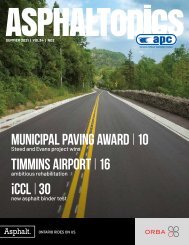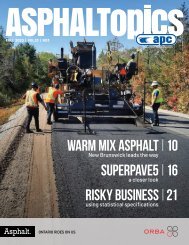ASPHALTopics | Spring 2018 | VOL 31 | NO 1
Create successful ePaper yourself
Turn your PDF publications into a flip-book with our unique Google optimized e-Paper software.
TECHNICALLY<br />
SPEAKING<br />
by Vince Aurilio & David Newcomb<br />
The merits of balanced mix design<br />
There have been a lot of changes or advancements in<br />
asphalt technology over the last fifteen to twenty years.<br />
We have also seen a number of significant changes in<br />
understanding the materials used to produce hot mix<br />
asphalt (HMA). However, there are still a number of<br />
challenges to the continuous improvement of asphalt<br />
mixture performance. The current methods used to<br />
perform volumetric mixture designs are only indirectly<br />
related to the quality of the material, and its time to<br />
re-evaluate how we do mix designs.<br />
The 1960s and 1970s were an era where fatigue<br />
cracking was somewhat common. In response, changes<br />
to structural designs were made that resulted in thicker<br />
HMA layers, and mixture designs were adjusted to allow<br />
for more asphalt in the mixtures. In the 1980s, rutting<br />
(permanent deformation) was a major problem across<br />
the U.S. and Canada. A number of key changes were<br />
made to address this issue such as the introduction<br />
of aggregate shape and texture, the adoption of PG<br />
binder grading, and rut testing. Rutting is now not as<br />
troublesome as it used to be. However, there are still<br />
more performance issues to be addressed.<br />
The focus has shifted back to solving the issues of<br />
lack of durability and premature cracking in asphalt<br />
pavements. There have also been a number of important<br />
materials changes, including increased use of RAP/RAS,<br />
the switch to Performance Graded Asphalt Binders, and<br />
the necessity to modify asphalt cement using different<br />
processes, some of which may have contributed to the<br />
present issues. In addition, we have seen changes to the<br />
mix type selection and/or the mix design process.<br />
The introduction of Superpave and mixes like stone<br />
mastic asphalt (SMA) and more recently warm mix asphalt<br />
(WMA) have been innovative and have provided our<br />
industry with more tools. However, as these technologies<br />
evolved, many of our approaches to mix design and<br />
quality control have remained in the pre-1980s in terms<br />
of how we design and test mixtures. When our materials<br />
CRACKING<br />
RUTTING<br />
40 OAPC | ASPHALTOPICS<br />
MIX<br />
DESIGN

















